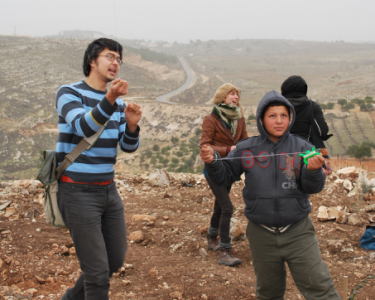This really does have to do with cartography, and if you think it’s inappropriate you can take it up with the management.

New York Magazine commissioned this map of ‘sluttiness’ in NYC based on OK Cupid (the dating site) data. Curious.
This really does have to do with cartography, and if you think it’s inappropriate you can take it up with the management.

New York Magazine commissioned this map of ‘sluttiness’ in NYC based on OK Cupid (the dating site) data. Curious.
Josh Levinger and I met up with some activists who were planting trees in Umm Salamuna (view in Google Maps) on a hillside which is scheduled to be annexed by a nearby Israeli settlement, and converted into a graveyard. The planting was organized by Alice Gray of Bustan Qaraaqa, so that if the land is taken over, the trees would have to be uprooted or chopped down before the land can be used.. As I understand it, one of the means by which settlements claim land is by using an Israeli law which opens land to new settlement if it has lain fallow for more than three years — so planting the hillside may defend it from such a claim.
The wind was so strong that our first kite, carefully made that morning from dowels and Tyvek, shattered immediately. Instead, we launched a small soft kite with an iPod nano attached to it. Here’s a stitched image of the video footage we captured:
See all the pictures on Flickr.
The iPod has an SD camera which can capture many hours of video – and it’s so super light that we can fly it on a pocket kite. Many of the frames are blurred and the resolution is pretty poor (we’d thought of using a Flip camera but they’re more expensive and heavier) but when you go through the footage frame by frame you can find lots of good images. We then stitched these together with Calico and got the above image. It helped a lot to put a small ‘sail’ on the back of the iPod so it didn’t spin as much.

Everyone was cold but once we started flying the kites we all got really excited. The owner of the land was there with his kids and they helped assemble the rig and fly the kite:

The mapping was a big success – everyone ‘got’ why we were doing it, that documenting the tree planting and how they’re changing the landscape is a form of testimony. We’re still working to rectify the imagery, and I’d like to ask folks if they have any ideas – the stitching software we’re using assumes images were taken from a single viewpoint, but the kite and camera were moving all over the place. As you can see above, the stitching distorts things and we lose a lot of detail – how can we reconstruct a high-res image that assumes multiple perspectives? I’m looking at this tutorial to start with. We’re also thinking about an algorithm to dump the clear, undistorted and unblurred frames from a movie file. Ideas?
Update: We’ll be adding this material to the Grassroots Mapping wiki, where we’re putting together a comprehensive guide on low-cost participatory mapping techniques. Our hope is that we can offer a Grassroots Mapping Kit which people can use to reproduce these techniques to explore and document their own geographies no matter where they are.
Cross-posted with the Center for Future Civic Media blog

Josh Levinger of GroundTruth and I tested our larger 8 foot balloon yesterday, and it was a huge success! We ran all the way through our spool of string, and got some great images before the light got too dim. I rectified them using Map Warper (fantastic!) and we now have a mostly continuous ‘scan’ of our flight.
This means this can be a viable way to capture high-resolution geolocated imagery at low cost! I spent under $100 on the equipment – $30 for the balloon, $40 for the camera, $5 for the helium, and a few bucks for string. I bet it could be done for under $50 with a cheaper camera and perhaps trash bags instead of latex balloons. We’ll be trying that soon – I’d guess we need about 10 of these 98-gallon bags. I also turned the ISO way up for this because the light was failing, so the photos are pretty grainy. This camera doesn’t have shutter speed settings, though I’m still playing around with the CHDK settings so maybe I’ll do better next time.
I’m excited to test this in an area that really does not have good aerial imagery, like outside Lima, Peru.
See all the pictures at full resolution here: Balloon aerial photography on Flickr
See some great photos from the ground by Christina Xu on Flickr


I’ve been taking very high-res imagery from a weather balloon and rectifying it, but the OpenStreetMap data isn’t detailed enough to find rectifying points… the result is a bit like this:
To add a Google layer, just run:
to_map.addLayer(googleSat,{'maxZoomLevel':22});
or drag this bookmarklet into your browser bookmarks bar, and click the bookmark when you’re on the Rectify page:
The result is something like this:
Halcyon Actionscript 3 renderer/editor for OpenStreetMap, by Richard Fairhurst et al. Part of Potlatch.

Playing with Map Warper (see recent post) and trying to rectify drawn maps for inclusion in Cartagen. Doesn’t work that well… the warper assumes smooth distortions, not ones based on people’s semantic and decidedly qualitative understanding of space. An alternative stretching algorithm might be interesting… regardless Map Warper should work well with balloon photography. More soon.
Continue reading “Map Warper with Cartagen – rectified sketches on dynamic maps”